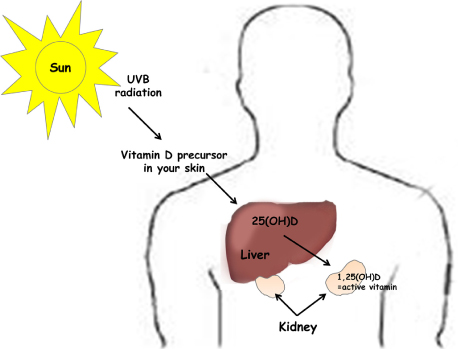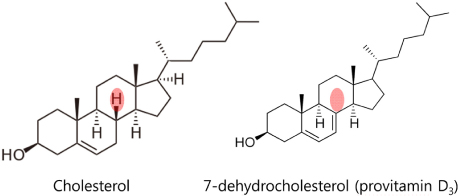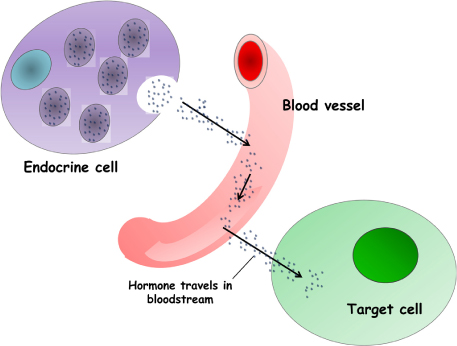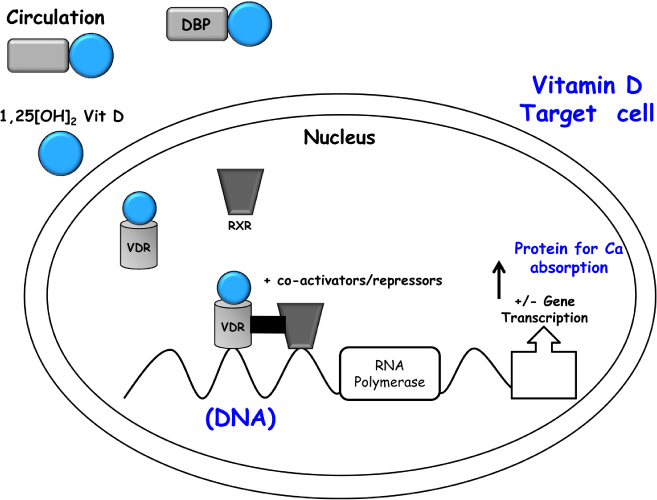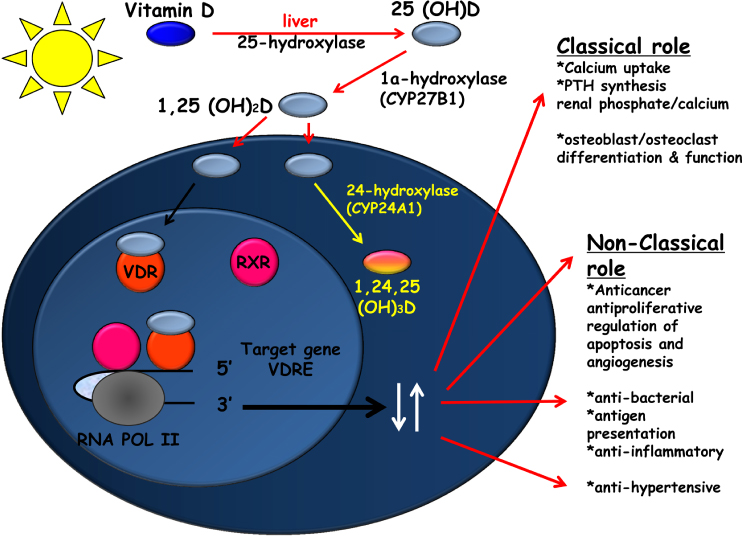J Nutr Health.
2016 Feb;49(1):1-7. 10.4163/jnh.2016.49.1.1.
Vitamin D: Hormone-like nutrient
- Affiliations
-
- 1Department of Food Science and Nutrition, Andong National University, Andong 36729, Korea. iskwun@andong.ac.kr
- KMID: 2158300
- DOI: http://doi.org/10.4163/jnh.2016.49.1.1
Abstract
- PURPOSE
The aim of this review is to comprehensively summarize the definition of vitamin D as a nutrient as well as a hormone-like molecule and its new function in prevention of various chronic diseases.
METHODS
The review was written by the method for systematic reivew writing. Literatures from the various sources, including research articles, book chapters, proceedings and electronic materials as appropriate, were screened first and then reviewed and analyzed for the review.
RESULTS
Vitamin D was originally considered as the essential nutrient as a vital carbon compound and was first discovered among children with osteomalacia, also known as ricket disease, characterized by poorly calcified bones which were easily bent rather than broken. Since that time, vitamin D has been known as the key nutrient to improve bone health. However, recently emerging study findings have shown that vitamin D acts as the hormone-like nutrient since it is synthesized like a hormone when our body needs and this particular vitamin also acts like a cell signaling ligand which regulates gene expression of various proteins. So far positive effects of vitamin D have been suggested for the action of anticancer, anti-immune function, and anti-cardiovascular disease, as well as antidiabetic function, etc. In this review, the definition for vitamin D as a nutrient vitamin as well as a hormone-like molecule, cell signaling mechanism of vitamin D, and finally the potential role for the prevention of chronic diseases are discussed.
CONCLUSION
Vitamin D is now being considered as a vital nutrient as a vitamin and as a potential substance for prevention of several chronic diseases.
Keyword
MeSH Terms
Figure
Cited by 1 articles
-
Pharmacologic supplementation of vitamin D
Jae Hyuk Lee
J Korean Med Assoc. 2017;60(4):330-335. doi: 10.5124/jkma.2017.60.4.330.
Reference
-
1. Jackson RD, LaCroix AZ, Gass M, Wallace RB, Robbins J, Lewis CE, Bassford T, Beresford SA, Black HR, Blanchette P, Bonds DE, Brunner RL, Brzyski RG, Caan B, Cauley JA, Chlebowski RT, Cummings SR, Granek I, Hays J, Heiss G, Hendrix SL, Howard BV, Hsia J, Hubbell FA, Johnson KC, Judd H, Kotchen JM, Kuller LH, Langer RD, Lasser NL, Limacher MC, Ludlam S, Manson JE, Margolis KL, McGowan J, Ockene JK, O'Sullivan MJ, Phillips L, Prentice RL, Sarto GE, Stefanick ML, Van Horn L, Wactawski-Wende J, Whitlock E, Anderson GL, Assaf AR, Barad D. Women's Health Initiative Investigators. Calcium plus vitamin D supplementation and the risk of fractures. N Engl J Med. 2006; 354(7):669–683.
Article2. Anderson PH, Atkins GJ. The skeleton as an intracrine organ for vitamin D metabolism. Mol Aspects Med. 2008; 29(6):397–406.
Article3. Dusso AS, Brown AJ, Slatopolsky E. Vitamin D. Am J Physiol Renal Physiol. 2005; 289(1):F8–F28.
Article4. Khan KS, Kunz R, Kleijnen J, Antes G. Five steps to conducting a systematic review. J R Soc Med. 2003; 96(3):118–121.
Article5. Holick MF. Vitamin D deficiency. N Engl J Med. 2007; 357(3):266–281.
Article6. Reddy Vanga S, Good M, Howard PA, Vacek JL. Role of vitamin D in cardiovascular health. Am J Cardiol. 2010; 106(6):798–805.
Article7. Davis CD, Milner JA. Nutrigenomics, vitamin D and cancer prevention. J Nutrigenet Nutrigenomics. 2011; 4(1):1–11.
Article8. Vitamin D and your health: breaking old rules, raising new hopes [Internet]. Boston (MA): Harvard Health Publications;2009. Jun. 9. cited 2015 Nov 10. Available from: http://www.health.harvard.edu/newsweek/vitamin-d-and-your-health.htm.9. Ahn J, Albanes D, Berndt SI, Peters U, Chatterjee N, Freedman ND, Abnet CC, Huang WY, Kibel AS, Crawford ED, Weinstein SJ, Chanock SJ, Schatzkin A, Hayes RB. Prostate, Lung, Colorectal and Ovarian Trial Project Team. Vitamin D-related genes, serum vitamin D concentrations and prostate cancer risk. Carcinogenesis. 2009; 30(5):769–776.
Article10. Haussler MR, Haussler CA, Whitfield GK, Hsieh JC, Thompson PD, Barthel TK, Bartik L, Egan JB, Wu Y, Kubicek JL, Lowmiller CL, Moffet EW, Forster RE, Jurutka PW. The nuclear vitamin D receptor controls the expression of genes encoding factors which feed the "Fountain of Youth" to mediate healthful aging. J Steroid Biochem Mol Biol. 2010; 121(1-2):88–97.
Article11. Joshi S, Pantalena LC, Liu XK, Gaffen SL, Liu H, Rohowsky-Kochan C, Ichiyama K, Yoshimura A, Steinman L, Christakos S, Youssef S. 1,25-dihydroxyvitamin D(3) ameliorates Th17 autoimmunity via transcriptional modulation of interleukin-17A. Mol Cell Biol. 2011; 31(17):3653–3669.12. Kolek OI, Hines ER, Jones MD, LeSueur LK, Lipko MA, Kiela PR, Collins JF, Haussler MR, Ghishan FK. 1alpha,25-Dihydroxyvitamin D3 upregulates FGF23 gene expression in bone: the final link in a renal-gastrointestinal-skeletal axis that controls phosphate transport. Am J Physiol Gastrointest Liver Physiol. 2005; 289(6):G1036–G1042.13. Haussler MR, Whitfield GK, Kaneko I, Haussler CA, Hsieh D, Hsieh JC, Jurutka PW. Molecular mechanisms of vitamin D action. Calcif Tissue Int. 2013; 92(2):77–98.
Article14. Bergwitz C, Jüppner H. Regulation of phosphate homeostasis by PTH, vitamin D, and FGF23. Annu Rev Med. 2010; 61:91–104.
Article15. Bikle D. Extrarenal synthesis of 1,25-dihydroxyvitamin D and its health implications. In : Holick MF, editor. Vitamin D: physiology, molecular biology, and clinical applications. 2nd edition. New York (NY): Humana;2010. p. 277–295.16. Demay MB, Kiernan MS, DeLuca HF, Kronenberg HM. Sequences in the human parathyroid hormone gene that bind the 1,25-dihydroxyvitamin D3 receptor and mediate transcriptional repression in response to 1,25-dihydroxyvitamin D3. Proc Natl Acad Sci U S A. 1992; 89(17):8097–8101.
Article17. Murillo G, Matusiak D, Benya RV, Mehta RG. Chemopreventive efficacy of 25-hydroxyvitamin D3 in colon cancer. J Steroid Biochem Mol Biol. 2007; 103(3-5):763–767.
Article18. Mora JR, Iwata M, von Andrian UH. Vitamin effects on the immune system: vitamins A and D take centre stage. Nat Rev Immunol. 2008; 8(9):685–698.
Article19. Adams JS, Hewison M. Unexpected actions of vitamin D: new perspectives on the regulation of innate and adaptive immunity. Nat Clin Pract Endocrinol Metab. 2008; 4(2):80–90.
Article20. Artaza JN, Mehrotra R, Norris KC. Vitamin D and the cardiovascular system. Clin J Am Soc Nephrol. 2009; 4(9):1515–1522.
Article21. Grundmann M, von Versen-Höynck F. Vitamin D - roles in women's reproductive health? Reprod Biol Endocrinol. 2011; 9:146.
Article22. UCLA Orthopaedic Surgery (US). Vitamin D and human health [Internet]. Los Angeles (CA): UCLA Heath;cited 2015 Dec 10. Available from: http://ortho.ucla.edu/body.cfm?id=205.
- Full Text Links
- Actions
-
Cited
- CITED
-
- Close
- Share
- Similar articles
-
- Food, Nutrient, and the Risk of Breast Cancer
- Comparison of Nutrient Calculation Programs for Dietary Intake Analysis
- The Effect of Seasoning on the Distribution of Nutrient Intakes by a Food-Frequency Questionnaire in a Rural Area
- Relationship between Red Pepper Intake, Capsaicin Threshold, Nutrient Intake, and Anthropometric Measurements in Young Korean Women
- Elementary School Children's Nutrient Intakes by School Lunch in Jeonbuk Area

